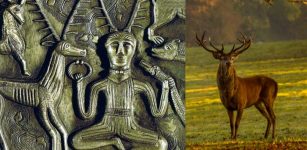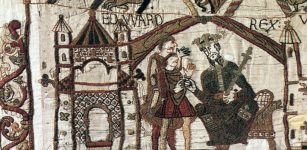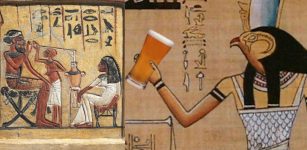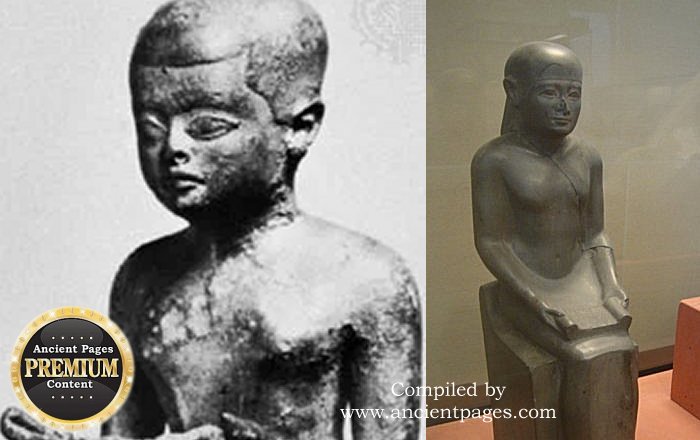Imhotep: Ancient Genius And Architect Of The Sakkara Pyramid
A. Sutherland - AncientPages.com - He was well-known for his intelligence and wisdom. Imhotep, or "he who comes in peace," was an ancient Egyptian genius and the great architect of the world's first known monumental stone building, the Step Pyramid at Sakkara.
A Great Mind Of Ancient Egypt
Born in the 27th century BC in Ankhtowe, a suburb of Memphis, Egypt, Imhotep showed he had many talents very early.
Imhotep's father, Kanofer, a celebrated architect, was later known to be the first of a long line of master builders who contributed to Egyptian works through the reign of King Darius the First (522–486 BC).
Imhotep followed in his father's footsteps and became even more influential. He was the inventor of the Sakarra (Saqqara) pyramid and the author of ancient wisdom, architect, high priest, physician, astronomer, and writer. His knowledge was so vast that he was later promoted to the status of a god and became worshipped as the god of medicine in Egypt and Greece, where he was identified with the Greek god of medicine, Asclepius.
This is a preview of our premium article available only to members of Ancient Pages.
Become a member to read more - Click here
If you are already a member and have logged in to your account, you can access the article here
See also:
Ancient Mystery Of Pharaohs And Gods With Two Left Or Two Right Hands – A Deeper Investigation
Surprising Ancient Signs Found On The Ceiling Of An Egyptian Temple In Saqqara Could Rewrite History
More From Ancient Pages Library Of Ancient And Unexplained Mysteries
More From Ancient Pages
-
 Crop Circles: Are They Cosmic Messages That We Cannot Decipher?
Featured Stories | Mar 26, 2019
Crop Circles: Are They Cosmic Messages That We Cannot Decipher?
Featured Stories | Mar 26, 2019 -
 Mystery Of The Horrible ‘Thing’ Found In A Dominican Monastery
Featured Stories | Sep 4, 2023
Mystery Of The Horrible ‘Thing’ Found In A Dominican Monastery
Featured Stories | Sep 4, 2023 -
 Does A Baffling Artifact Offer Evidence Of Ancient Extraterrestrial Visitation In New Zealand? – The Discovery – Part 1
Ancient Mysteries | Jul 20, 2020
Does A Baffling Artifact Offer Evidence Of Ancient Extraterrestrial Visitation In New Zealand? – The Discovery – Part 1
Ancient Mysteries | Jul 20, 2020 -
 Was Spruce Hill In Ohio Home To An Ancient Lost Civilization? Traces Of Strong Fire Puzzle Scientists
Ancient Mysteries | Jan 17, 2018
Was Spruce Hill In Ohio Home To An Ancient Lost Civilization? Traces Of Strong Fire Puzzle Scientists
Ancient Mysteries | Jan 17, 2018 -
 Völuspá – Norse Prophecy Of The Völva, A Feared Shaman By The Vikings
Featured Stories | Mar 26, 2018
Völuspá – Norse Prophecy Of The Völva, A Feared Shaman By The Vikings
Featured Stories | Mar 26, 2018 -
 Cernunnos ‘Horned One’ – Powerful Continental God Preserved In Celtic Beliefs As Master Of Animals
Celtic Mythology | Dec 18, 2018
Cernunnos ‘Horned One’ – Powerful Continental God Preserved In Celtic Beliefs As Master Of Animals
Celtic Mythology | Dec 18, 2018 -
 Mysterious Greyfriars Kirkyard: A Cemetery In Edinburgh With Dark And Spooky History
Featured Stories | Sep 16, 2016
Mysterious Greyfriars Kirkyard: A Cemetery In Edinburgh With Dark And Spooky History
Featured Stories | Sep 16, 2016 -
 Secrets Of The Freemasons – Masonic Symbols Reveal Worship Of Ancient Mother Goddesses
Ancient Mysteries | Jun 18, 2018
Secrets Of The Freemasons – Masonic Symbols Reveal Worship Of Ancient Mother Goddesses
Ancient Mysteries | Jun 18, 2018 -
 Yokai Hone-Onna (‘Skeleton Woman’): Deceptive Succubus That Feeds On Man’s Soul And Vitality In Japanese Folklore
Featured Stories | Jan 20, 2020
Yokai Hone-Onna (‘Skeleton Woman’): Deceptive Succubus That Feeds On Man’s Soul And Vitality In Japanese Folklore
Featured Stories | Jan 20, 2020 -
 A 200-Year-Old Swedish Mystery Remains Unsolved
Ancient Mysteries | Oct 7, 2015
A 200-Year-Old Swedish Mystery Remains Unsolved
Ancient Mysteries | Oct 7, 2015 -
 Axis Mundi That Symbolizes Separation Of The Earth From The Heaven
Featured Stories | Jul 2, 2018
Axis Mundi That Symbolizes Separation Of The Earth From The Heaven
Featured Stories | Jul 2, 2018 -
 The Bayeux Tapestry: One Of The Great Historical Records Of The Middle Ages
Artifacts | Feb 29, 2016
The Bayeux Tapestry: One Of The Great Historical Records Of The Middle Ages
Artifacts | Feb 29, 2016 -
 Beer Was Used As Medicine And Payment In Ancient Egypt
Ancient History Facts | Feb 11, 2018
Beer Was Used As Medicine And Payment In Ancient Egypt
Ancient History Facts | Feb 11, 2018 -
 Sacred Artifact With Mystical Powers – The Discovery – Part 2
Ancient Mysteries | Apr 26, 2019
Sacred Artifact With Mystical Powers – The Discovery – Part 2
Ancient Mysteries | Apr 26, 2019 -
 Boann – The Goddess Who Gave Life To The River Boyne In Celtic Mythology
Celtic Mythology | Jun 9, 2018
Boann – The Goddess Who Gave Life To The River Boyne In Celtic Mythology
Celtic Mythology | Jun 9, 2018 -
 Killer-Of-Enemies – Mysterious Non-Human Teacher And Hero Of The Apache Indians
Featured Stories | Nov 16, 2020
Killer-Of-Enemies – Mysterious Non-Human Teacher And Hero Of The Apache Indians
Featured Stories | Nov 16, 2020 -
 Diyu – Terrible Chinese Hell And Judgement Of God Yama
Chinese Mythology | Dec 18, 2018
Diyu – Terrible Chinese Hell And Judgement Of God Yama
Chinese Mythology | Dec 18, 2018 -
 Blood Of St. Januarius – One Of The Most Remarkable Christian Relics
Artifacts | Jun 27, 2017
Blood Of St. Januarius – One Of The Most Remarkable Christian Relics
Artifacts | Jun 27, 2017 -
 A 4,500-Year-Old Collective Tomb In France Reveals Its Secret – The Final Stage In The Formation Of The ‘European Genome’
Featured Stories | Jul 5, 2024
A 4,500-Year-Old Collective Tomb In France Reveals Its Secret – The Final Stage In The Formation Of The ‘European Genome’
Featured Stories | Jul 5, 2024 -
 Robert Fortune’s Dangerous Mission To Obtain Tea From The Chinese
Featured Stories | Feb 24, 2020
Robert Fortune’s Dangerous Mission To Obtain Tea From The Chinese
Featured Stories | Feb 24, 2020



